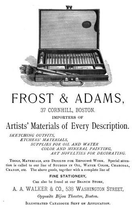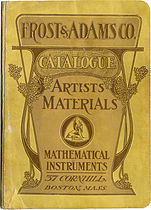
James Wallace Black, known professionally as J.W. Black, was an early American photographer whose career was marked by experimentation and innovation.

Southworth & Hawes was an early photographic firm in Boston, 1843–1863. Its partners, Albert Sands Southworth (1811–1894) and Josiah Johnson Hawes (1808–1901), have been hailed as the first great American masters of photography, whose work elevated photographic portraits to the level of fine art. Their images are prominent in every major book and collection of early American photography.
Smith, Elder & Co., alternatively Smith, Elder, and Co. or Smith, Elder and Co. was a British publishing company which was most noted for the works it published in the 19th century. It was purchased by John Murray in the early 1900s, its archive now kept as part of the John Murray Archive at the National Library of Scotland in Edinburgh, Scotland.

The Boston Music Hall was a concert hall located on Winter Street in Boston, Massachusetts, with an additional entrance on Hamilton Place.
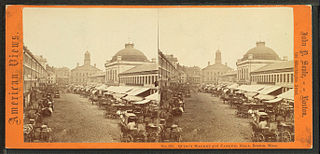
John Payson Soule (1828–1904) was a photographer and publisher in Boston, Massachusetts, and Seattle, Washington.

Abram French (1815–1884) was a crockery, glassware, and china dealer in 19th-century Boston, Massachusetts.

Merchants Row in Boston, Massachusetts is a short street extending from State Street to Faneuil Hall Square in the Financial District. Since the 17th century it has been a place of commercial activity. It sits close to Long Wharf and Dock Square, hubs of shipping and trade through the 19th century. Portions of the street were formerly known as Swing-Bridge Lane, Fish Lane, and Roebuck Passage.
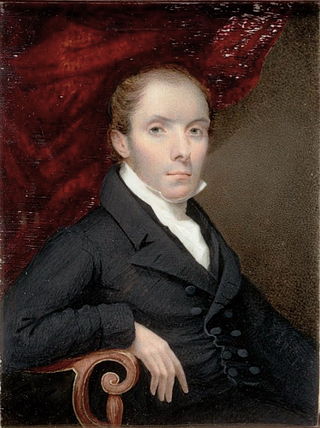
Thomas Edwards (1795–1869) was an artist in 19th-century Boston, Massachusetts, specializing in portraits. Born in London and trained at the Royal Academy, he worked in Boston in the 1820s-1850s, and in Worcester in the 1860s.
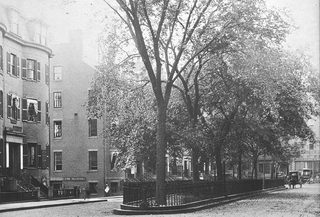
Pemberton Square in the Government Center area of Boston, Massachusetts, was developed by P.T. Jackson in the 1830s as an architecturally uniform mixed-use enclave surrounding a small park. In the mid-19th century both private residences and businesses dwelt there. The construction in 1885 of the massive John Adams Courthouse changed the scale and character of the square, as did the Center Plaza building in the 1960s.

Cornhill was a street in Boston, Massachusetts, in the 18th, 19th and 20th centuries, located on the site of the current City Hall Plaza in Government Center. It was named in 1829; previously it was known as Market Street (1807–1828). In its time, it comprised a busy part of the city near Brattle Street, Court Street and Scollay Square. In the 19th century, it was the home of many bookstores and publishing companies. As of 1969, Cornhill exists as 144 feet along the edge of City Hall Plaza.

Francis Seth Frost (1825–1902) or F.S. Frost was a painter, photographer, and businessman specializing in artists' materials. Based in Boston, Massachusetts, he travelled widely in the United States. Friends included Albert Bierstadt. Frost kept an art studio in the Studio Building on Tremont Street in Boston. In 1869 with E.H. Adams he began the artists' supply firm, Frost & Adams, which flourished into the 20th century.

Young's Hotel (1860–1927) in Boston, Massachusetts, was located on Court Street in the Financial District, in a building designed by William Washburn. George Young established the business, later taken over by Joseph Reed Whipple and George G. Hall. Guests at Young's included Mark Twain, Elizabeth Cady Stanton, William Lloyd Garrison, Charles Sumner, Rutherford B. Hayes, and numerous others.
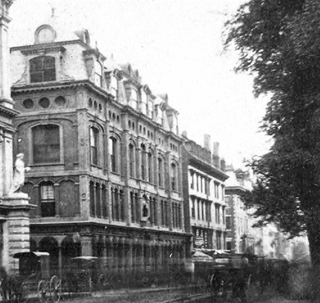
The Studio Building (1861–1906) on Tremont Street in Boston, Massachusetts, housed artists' studios, theater companies and other businesses in the 19th century. It "held the true Bohemia of Boston, where artists and literati delighted to gather." Among the tenants were portraitist E.T. Billings, architect George Snell, sculptor Martin Milmore, artists William Morris Hunt, William Rimmer, Edward Mitchell Bannister, Phoebe Jenks; gallerist Seth Morton Vose, and many others.
Amory Nelson Hardy or A.N. Hardy (1835–1911) was a photographer in Boston, Massachusetts, in the 19th century. Portrait subjects included US president Chester A. Arthur, clergyman Henry Ward Beecher, politician James G. Blaine, abolitionist William Lloyd Garrison, doctor Oliver Wendell Holmes Sr., jurist Oliver Wendell Holmes Jr., writer Julia Ward Howe, labor activist Florence Kelley, suffragist Mary Livermore, philanthropist Isabella Somerset, and suffragist Frances Willard. He also made "electric-light portraits" of roller skaters in 1883.

Bela Marsh (1797-1869) was a publisher and bookseller in Boston, Massachusetts, in the 19th century. Authors under his imprint included spiritualists and abolitionists such as John Stowell Adams, Adin Ballou, Warren Chase, Lysander Spooner, and Henry Clarke Wright. Marsh kept offices on Washington Street (ca.1820-1832), Cornhill (ca.1847-1852), Franklin Street (ca.1854-1856), and Bromfield Street (ca.1858-1868). Among his business partners were Nahum Capen, Gardner P. Lyon, T.H. Webb, and George W. Williams. He belonged to the Massachusetts Charitable Mechanic Association and the Physiological Society.

B.F. Keith's Theatre (1894–1928) in Boston, Massachusetts, was a vaudeville playhouse run by B.F. Keith. It sat across from Boston Common in the city's theatre district, with an entrance on Tremont Street and another on Washington Street. Personnel included Keith, E.F. Albee and H.E. Gustin. Virgilio Tojetti painted some of the interior decorations. In 1939, the theater was converted to a movie theater named the Normandie.
The Grand Opera House (est.1888) of Boston, Massachusetts, was a theatre in the South End. Architect George Snell designed the 2,600-seat building on Washington Street. Managers and proprietors included Proctor & Mansfield, A.H. Dexter, George W. Magee, and Stair & Wilbur. Performances included Glyn's Three Weeks.
The Fenway Theatre (1915–1972) of Boston, Massachusetts, was a cinema and concert hall in the Back Bay, located at no.136 Massachusetts Avenue at Boylston Street. Architect Thomas W. Lamb designed the building; its interior was "marble and velvet." The auditorium sat 1,600. In the early 1970s Aerosmith used the theatre for rehearsals. In 1972 the Berklee College of Music bought the property; the remodeled Berklee Performance Center opened in 1976 and continues today.
The Gaiety Theatre (1908–1949) or Gayety Theatre of Boston, Massachusetts, was located at no.661 Washington Street near Boylston Street in today's Boston Theater District. It featured burlesque, vaudeville and cinema. Performers included Clark and McCullough, Solly Ward, and Lena Daley; producers included Charles H. Waldron, Earl Carroll, and E.M. Loew. In 1949 it became the "Publix Theatre." The building existed until its razing in 2005.

Adams Square (1879–1963) was a square in downtown Boston, Massachusetts. Now demolished, it was formerly located on the site of the current Boston City Hall in Government Center.

















